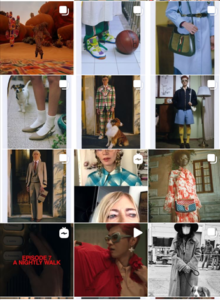As we all know, we are living in the height of a digital age, in which new marketing methods are being discovered every day. That fact, the capacity and speed of communication, that the world is now experiencing, have made it a difficult task to achieve some exclusivity for some brands. This is how the concept of ” fast fashion ” arises. Prior to this, clothing brands only created two seasons per year, spring / summer and fall / winter. Now retailers apart from focusing on these collections also focus on designing and producing small collections every 3/4 weeks with shorter life cycles due to consumer demand, which now create relationships with brands (Bhardwaj and Fairhurst, 2010). One of the digital tools that has potentiated the digital transformation of brands are social networks, apart from serving to promote the product and attract customers, it also serves to create brand value with the consumer and to deepen the relationship with them (Bertola and Teunissen, 2018). Now that customers are more demanding and more discerning, consumer brand engagement becomes more valuable and difficult to achieve. What social networks seek to achieve is high engagement with their consumer community and thus, their loyalty (Hollebeek et al, 2014). Instagram is one of the main social networks that moves the most information flow daily and due to this overload of visual information to which consumers are exposed, brands must make their way through the chaos that is generated in the social network to attract the attention of consumers, especially millennials who are the platform’s most active target (Valentini et al, 2018). Luxury brands are using this social network in various ways, some have chosen to add elegance and sophistication to the feed through pastel colors and ordered geometric figures, seeking to simplify the product while others use striking colors and images with creative shapes getting a feed abstract aesthetic in order to grab the user’s attention (Chu et al, 2013).
Chanel is one of those brands whose presence on Instagram is classic. It shows the product a lot, it follows lines of sophisticated colors such as black and gold, which reflect luxury, power and sensuality (Jin and Ryu, 2019). It also does not use any of the tools that Instagram offers for brands, such as the store option, IGTV videos, highlights, etc. Despite this, Chanel ranks first, being the luxury brand with the most Instagram followers (41,9M) (Khan, 2018).


The second luxury brand with the most followers on the social network is Gucci (41,6M) (Athwal et al, 2019). Although the visual elements of the brand are not at all aligned with each other, they have an ordered feed within their disorder, by this we mean that, in the instagram structure, the three images of each line agree although not always but not with each other, the posts don’t follow a colored line either.


Then there are other brands, such as Burberry or Michael Kors that make use of all the elements that instagram offers, they have highlights from collections, they upload reels about their products and IGTV telling stories, they also have the ‘buy’ section up to date. Although the feeds of these two brands match the visuals and colors, we highlight the good structure of the Michael Kors images, which makes his Instagram look like a Christmas card.




REFERENCES
Athwal, N., Istanbulluoglu, D., & McCormack, S. E. (2019). The allure of luxury brands’ social media activities: a uses and gratifications perspective. Information Technology & People.
Bertola, P., & Teunissen, J. (2018). Fashion 4.0. Innovating fashion industry through digital transformation. Research Journal of Textile and Apparel.
Bhardwaj, V., & Fairhurst, A. (2010). Fast fashion: response to changes in the fashion industry. The international review of retail, distribution and consumer research, 20(1), 165-173.
Chu, S. C., Kamal, S., & Kim, Y. (2013). Understnding consumers’ responses toward social media advertising and purchase intention toward luxury products. Journal of Global Fashion Marketing, 4(3), 158-174.
Hollebeek, L. D., Glynn, M. S., & Brodie, R. J. (2014). Consumer brand engagement in social media: Conceptualization, scale development and validation. Journal of interactive marketing, 28(2), 149-165.
Jin, S. V., & Ryu, E. (2019). Instagram fashionistas, luxury visual image strategies and vanity. Journal of Product & Brand Management.
Khan, S. (2018). Instagram as a marketing tool for luxury brands. International Journal of Management, Business and Research, 8(2), 126.
Valentini, C., Romenti, S., Murtarelli, G. and Pizzetti, M. (2018), “Digital visual engagement: influencing purchase intentions on Instagram”, Journal of Communication Management, Vol. 22 No. 4, pp. 362-381.